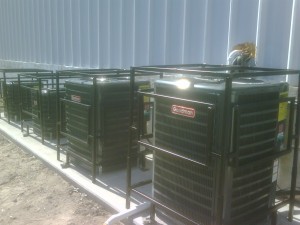They’re among the latest and greatest in heat pump technology, and they’re super efficient. The only higher rated systems are geothermal, rotary compressor, and solar systems. Many Lennox two-speed systems are solar ready.
So how do two-speed systems work? It’s a matter of a the compressor really. Two-speed systems typically have a two-stage or true-variable compressor in the outdoor unit. They’re best paired with a variable speed air handler and are great in zoned applications.
When the thermostat calls for cooling or heating and is within three degrees of the set point, the compressor ramps on in low speed. So a five-ton compressor acts like a 2.5 ton, drawing less amps and using less power. It will cool or heat the area more slowly but the byproduct of that is greater humidity control and more efficient operation. The only time the compressor is at full speed is during very high demand times, such as if the unit was shut off or if there is a larger number of people than normal in the room.
Typically, you can expect to see two-speed systems achieving 16 SEER and higher efficiency ratings. Many manufacturers add communicating features, fancy thermostats, and much of their own terminology to these two-speed systems. They’re a step above standard and typically come with a 10-year parts warranty directly from the manufacturer. If yours does not, make sure you double check this fact our and do your due diligence when selecting a contractor.
Two-speed systems are sophisticated and required adequate airflow for proper operation. If the static pressure in your duct system is too high or you don’t have multiple returns in your home, you may need to augment your duct system for proper system function.
When getting your home sized for a potential installation of a two-speed system, it is imperative that the contractor run a heat load of your home. Most two-speed systems come in whole sizes only. If you have a 3.5-ton unit right now, you will have to go up to a four-ton or down to a three-ton unit. How do you know which is best? For us, the best answer lies in education. You have to make an educated decision based on the btus your home requires to heat and cool it. This can only be determined by a trained professional performing a heat load calculation. It’s a free service we extend on all of our estimates, so don’t fret call Bayonet and we will help you. If you’re not local to the Tampa area, make sure you request that the contractor perform one during the estimate and confirm prior to making the appointment what the fees are–if any–for this service. Every system has a maximum btu output and your home may have had alterations to it over time, changing the required btus for the home as well. For example, many homeowners tint their windows, add insulation, install patios and upgrade the windows to double pane, low-e windows, which all have an effect on the btus required to heat and cool your home.
When selecting an AC unit, bigger isn’t always better! Don’t just assume that you want to go up in size, as super sizing can lead to super problems! Short cycling can increase the humidity levels in your home and mke if feel like a dank cave instead of a comfortable abode. If you choose to go bigger, know that your duct system will almost always need alterations too. Be very cautious of the contractor you’re using if they tell you otherwise. Most homes built before 2007 are running with undersized returns to begin with, so if you’re installing a larger system, count on duct improvements as well.
Besides bringing about a more comfortable home climate, two-speed systems are often much quieter than their single-speed counterparts. Most of that quietness is due to the low-speed operation and improved insulation and sound deadeners inside the cabinet. Inquire as to available rebates and incentives when inquiring as well, as these systems frequently have some immediate savings you can count on–even from your power company!
As always, don’t sweat, call Bayonet if you have further questions. From our homepage, you can always click the “Ask An Expert” graphic and one of our resident experts in their field will answer your question in 24 hours—or less!
Continue Reading


